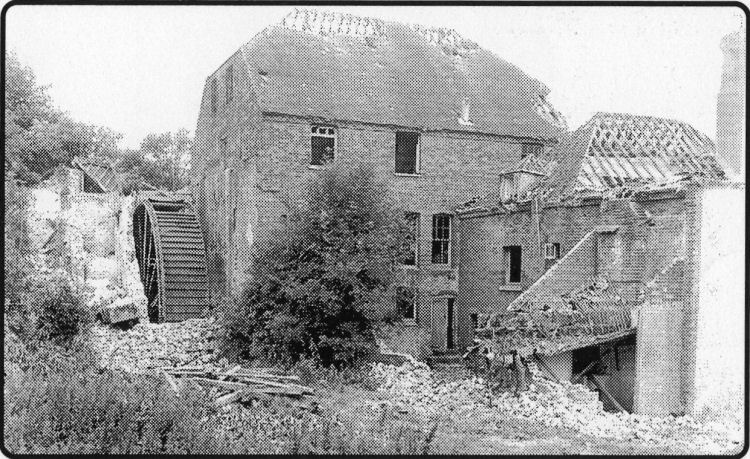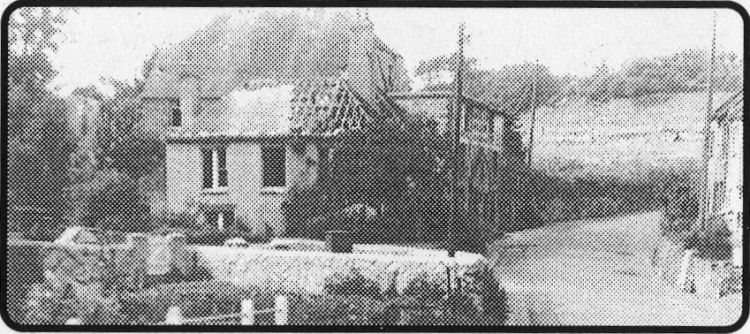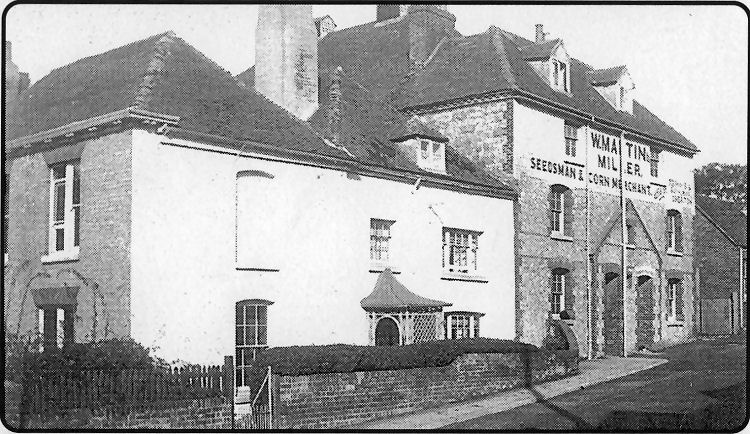
From the Folkestone Herald Published 11 May 2000
Historic mill.
BELIEVED to be the largest waterwheel of its kind ever made in Kent - 30ft
in diameter and 5ft wide - the Horn Street mill wheel sadly disappeared at
the hands of demolition men in 1961.

SAD SCENE as Horn Street watermill begins to disappear at the hands of
demolition contractors - in July 1961. The substantial structure was
photographed by Lambert & Weston on July 26 just after the work began.
Recollections of that sad occasion were revived by a feature in Memories a
few weeks ago about the family business and
photographs of Brian Swoffer, 80, of Wear Bay Crescent, Folkestone. The
family ran the old Horn Street Mill and were egg,
fruit and potato merchants with wholesale business premises in Dover Road,
next to the Martello public house.
The premises are now a modern veterinary surgery.
The Swoffer business was started at the end of the 19th Century by the two
brothers George
Iddenden Swoffer, a JP and Brian’s grandfather Edward.
They were two of a large family raised by Brian’s great grandfather, Alfred
Swoffer, who had shops in Dover.
Gt.-Gt. grandfather Edward Swoffer, a hairdresser, moved to Dover from
Faversham and brought up a large family.
The Memories feature set Alan Taylor leafing through his big
collection of local history-material and he came up with these pictures and
an account of the start of demolition of the 18th Century mill, from the
Herald of July 29,1961.
The mill was being cleared to create a site to build new homes over three
acres.
The earliest map reference dated it back nearly 200 years, to 1769. It was
owned, like others, by a Mr Pearce, a paper maker and flour miller according
to Hasted.
That historian referred to a mystery device that made
it possible, or so he said, to run the mill by both wind and water. But what
that was has never been revealed.
Paper and oil.
From 1821-1870 it was run by two generations of the Paine family, George and
John, producing paper and vegetable oil.
The giant waterwheel was made about 1840 by Sweetlove, of Wingham.
But in 1873 William B Horton of Hythe bought it for flour milling, leasing
it on a weekly tenancy in 1887
to Mr C.O. Russell, of Swanton, Mersham.
In 1900 Messrs Swoffer, of Folkestone took over but in 1919 it was bought by
a Mr Kenchington. East Kent miller William Martin took over six years later.
It last functioned as a mill in 1943 water being diverted from the nearby
stream via floodgates.
The mill site and adjacent pond, which had only seen a dribble of water for
years apparently, was sold to Hawkinge builder Mr R. Hagger for housing.

COTTAGES on the right next to the Britannia public house survive demolition
of Horn Street mill, above.

THE SEABROOK Valley Mill in the days of miller W. Martin Ltd. The firm ran a
business as Corn and Coal Merchants (Seabrook Valley Mill) at 55 Horn Street
from 1925-52 and as W Martin Ltd (Store) from 1952-56. The picture, like the
others, was shown to me by local historian Alan Taylor.
 |
|
1900
Bicycles and telephoto lenses aid for Boer War.
NEWLY developed telephoto lenses for
cameras were being seen by the War Office as an aid to war and a
party of seven Royal Engineers armed with cameras fitted to bicycles(!)
was dispatched to South Africa for use in the Boer War. Some of the news
dispatches from the besieged city of Ladysmith were reported to have
been carried by runners using bicycles in the dead of night. This
reduced the time taken to reach the coast from a week to three days. Sir
Richard Dickeson & Co, who had a business in Queen Street, Dover, were
given the contract to provide supplies for British troops ordered to St
Helena to guard Boer prisoners being taken there. On the soccer front at
home there were plenty of goals for Folkestone’s Easter supporters who
saw the home side notch five goals in the first half of their match with
Essex visitors who failed to score, suffering an 8-nil defeat. But away
to Faversham with a weakened side Folkestone lost 1 - 0 and at home on
Easter Monday they were unlucky to lose 1-0 against Deptford. Folkestone
Invicta in a friendly with Holy Trinity, won 5-0.
|
|
1925
Call to end live exports of hard working horses.
LIVE exports was a matter of great concern 75 years ago, but
then the trade objected to was that of the 'patient and hard-working
animal' the horse, sent slaughter for food in France and Belgium. An
anonymous letter writer called for the borough MP to press for a Bill in
Parliament to stop the trade. The Herald published a picture of Fl-Sgt GW Hunt, a foreman fitter, who lived in Folkestone before joining a
flight in the British airship R33 which was swept across the North Sea
In a recent gale. He and a fitter had worked for Mr A Haslam, local
manager of the Cambrian coach firm. Local lifesaving workers were
appealing for funds for a motor lifeboat at Folkestone stressing the
need due to the cross-Channel traffic to and from Folkestone. The
Southern Railway's popular cross-Channel passenger steamer Isle of
Thanet, described as a ‘miniature Atlantic liner' and costing £200,000,
was launched at Dumbarton; Tributes were paid, on the anniversary, to
two local volunteers who were among the servicemen In the famous First
World War attack on the German held port of Zeebrugge, Robert Griggs and
Mr AE Howett. The latter was said to have been the first man to set foot
on the Mole under heavy enemy fire.
|
|
1950
Early cine film recorded Shepway events of 1912.
BIG CROWDS at First Speedway, was the headline on a well
illustrated report of Folkestone Motor Cycle Club’s first of the season
race meetings at the newly lengthened Crete Road speedway track, there
being 6,000 spectators. Local riders’ names I particularly noted were J Canlni, A.C. (Monty) Banks, WJ Keel and D Spain. I was Interested to
read in The Roamer notebook column of the Herald that a cine film
survived of the 1912 carnival procession in the town In aid of the Royal
Victoria Hospital. That procession included Folkestone Fishermen’s Band.
Some 35 strong they played drums, fifes and bugles and wore uniforms
over their traditional tan frocks. Ail were believed to have learnt to
play by ear, being unable to read music. Other important local events
being shown at the Odeon cinema Included Queen Mary Inspecting troops at
Shorncliffe, 1910 flights at Shorncliffe by Capt E Maitland in a ‘string
bag’ of a plane which carried one of the early Marconi radio sets— and
the opening of the Leas Cliff Halt and an extension to the Royal
Victoria Hospital In 1927. The film was shown to Roamer by a reader who
was making a collection of films of past events In Folkestone. I wonder
where that film is today? Does any reader know?
|
|
1975
Attack on council record in helping the homeless.
A PROPOSAL by Shepway District Council that the Norfolk
Hotel should be returned to use as a hotel threatened to put 30 or 40
people “on the streets" according to a Herald headline 25 years ago. The
people concerned were said to be occupying self-catering flatlets In the
building. The council decision was as a result of “an unauthorised
change of use, from a hotel to self-catering flatlets/hostel!
Residents branded the council’s action as “Irresponsible, callous and
misconceived." The committee said the property was overcrowded,
considering its sanitary and fire precaution facilities. A Council
spokesman said: “We had regard to the fact the standard of accommodation
was not good enough. The Council did ask the landlords to apply for a
change of use last year, but no application was made." The hotel owners
were given until September 9 to comply. One woman lived in one room with
her husband and three children. She complained the council was not
building homes for the homeless and they had three times sought to get
on the housing list without success, The last time was in November and
they had not even had a reply, she claimed. “The Norfolk is the only
place in Folkestone that takes children,” she said. A director of the
hotel commented that for two years they had been doing the Council’s
work for them in housing the homeless. But, when they could, they
intended to re-open as a hotel.
|
|




